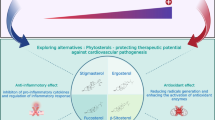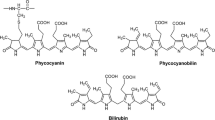Abstract
Purpose
Procyanidin B2 (PB2) is a naturally occurring flavonoid widely found in cocoa, red wine and grape juice. Recent studies have suggested that PB2 could protect against oxidative stress- and chemical-induced injury in colonic cells by modulating the endogenous cellular defence. However, the precise mechanism for this protection is not fully understood. Herein, we examined the effect of PB2 on the expression of one of the major antioxidant/detoxificant enzymes related to intestinal protection, the glutathione S-transferase P1 (GSTP1), and the molecular mechanisms involved.
Methods
Human colonic Caco-2 cells were treated with PB2 at different times and enzymatic activity, and mRNA and protein levels of GSTP1 were evaluated. The nuclear translocation of the transcription factor NF-erythroid 2-related factor (Nrf2) and the phosphorylation states of specific proteins central to intracellular signalling cascades were also investigated.
Results
PB2 induced the expression and activity of GSTP1 and the nuclear translocation of Nrf2. Interestingly, two important signalling proteins involved in Nrf2 translocation, the extracellular signal-regulated protein kinases (ERKs) and the p38 mitogen-activated protein kinase (MAPK) were also activated. Further experiments with specific inhibitors of both pathways confirmed their critical role in the beneficial effects induced by PB2.
Conclusions
The present results show that PB2 protects against oxidative injury in colonic cells and up-regulate the expression of GSTP1 via a mechanism that involves ERK and p38 MAPK activation and Nrf2 translocation. These results provide a molecular basis for the potential contribution of PB2 in the prevention of oxidative stress-related intestinal injury and gut pathologies.







Similar content being viewed by others
References
Aw TY (1999) Molecular and cellular responses to oxidative stress and changes in oxidation-reduction imbalance in the intestine. Am J Clin Nutr 70:557–565
Reuter S, Gupta SC, Chaturvedi MM, Aggarwal BB (2010) Oxidative stress, inflammation, and cancer: how are they linked? Free Radic Biol Med 49:1603–1616
Calder PC, Albers R, Antoine JM, Blum S, Bourdet-Sicard R, Ferns GA, Folkerts G, Friedmann PS, Frost GS, Guarner F, Lovik M, Macfarlane S, Meyer PD, M’ Rabet L, Serafini M, van Eden W, van Loo J, Vas Dias W, Vidry S, Winklhofer-Roob BM, Zhao J (2009) Inflammatory disease processes and interactions with nutrition. Br J Nutr 101:1–45
Aron PM, Kennedy JA (2008) Flavan-3-ols: nature, occurrence and biological activity. Mol Nutr Food Res 52:79–104
Crozier A, Jaganath IB, Clifford MN (2009) Dietary phenolics: chemistry, bioavailability and effects on health. Nat Prod Rep 26:1001–1043
Masella R, Di Benedetto R, Varì R, Filesi C, Giovannini C (2005) Novel mechanisms of natural antioxidant compounds in biological systems: involvement of glutathione and glutathione-related enzymes. J Nutr Biochem 16:577–586
Frova C (2006) Glutathione transferases in the genomics era: new insights and perspectives. Biomol Engin 23:149–169
Tsuchida S, Sato K (1992) Glutathione transferases and cancer. Crit Rev Biochem Mol Biol 27:337–384
Xia C, Hu J, Ketterer B, Taylor JB (1996) The organization of the human GSTP1–1 gene promoter and its response to retinoic acid and cellular redox status. Biochem J 313:155–161
Eggler AL, Gay KA, Mesecar AD (2008) Molecular mechanisms of natural products in chemoprevention: Induction of cytoprotective enzymes by Nrf2. Mol Nutr Food Res 52:S84–S94
Nguyen T, Yang CS, Pickett CB (2004) The pathways and molecular mechanisms regulating Nrf2 activation in response to chemical stress. Free Radic Biol Med 37:433–441
Ramiro-Puig E, Castell M (2009) Cocoa: antioxidant and immunomodulator. Br J Nutr 101:931–940
Serra A, Macià A, Romero MP, Valls J, Bladé C, Arola L, Motilva MJ (2010) Bioavailability of procyanidin dimers and trimers and matrix food effects in vitro and in vivo models. Br J Nutr 103:944–952
Visioli F, Bernaert H, Corti R (2009) Chocolate, lifestyle, and health. Crit Rev Food Sci Nutr 49:299–312
Kang NJ, Lee KW, Lee DE, Rogozin EA, Bode AM, Lee HJ, Dong Z (2008) Cocoa procyanidins suppress transformation by inhibiting mitogen-activated protein kinase kinase. J Biol Chem 283:20664–20673
Rodríguez-Ramiro I, Martín MA, Ramos S, Bravo L, Goya L (2011) Comparative effects of dietary flavanols on antioxidant defences and their response to oxidant-induced stress on Caco2 cells. Eur J Nutr. doi:10.1007/s00394-010-0139-2
Rodríguez-Ramiro I, Ramos S, Bravo L, Goya L, Martín MA (2011) Procyanidin B2 and a cocoa polyphenolic extract inhibit acrylamide-induced apoptosis in human Caco-2 cells by preventing oxidative stress and activation of JNK pathway. J Nutr Biochem. doi:10.1016/j.jnutbio.2010.10.005
Goya L, Mateos R, Bravo L (2007) Effect of the olive oil phenol hydroxytyrosol on human hepatoma HepG2 cells. protection against oxidative stress induced by tert-butylhydroperoxide. Eur J Nutr 46:70–78
Lima CF, Valentao PC, Andrade PB, Seabra RM, Fernandes-Ferreira M, Pereira-Wilson C (2007) Phenolic compounds protect HepG2 cells from oxidative damage: relevance of glutathione levels. Chem Biol Interact 167:107–115
Martín MA, Serrano AB, Ramos S, Pulido MI, Bravo L, Goya L (2010) Cocoa flavonoids up-regulate antioxidant enzyme activity via the ERK1/2 pathway to protect against oxidative stress-induced apoptosis in HepG2 cells. J Nutr Biochem 21:196–205
Scalbert A, Johnson IT, Saltmarsh M (2005) Polyphenols: antioxidants and beyond. Am J Clin Nutr 81:215S–217S
Hou DX, Kumamoto T (2010) Flavonoids as protein kinase inhibitors for cancer chemoprevention: direct binding and molecular modeling. Antioxid Redox Signal 13:691–719
Chou SC, Kaur M, Thompson JA, Agarwal R, Agarwal C (2010) Influence of gallate esterification on the activity of procyanidin B2 in androgen-dependent human prostate carcinoma LNCaP cells. Pharm Res 27:619–627
Dinkova-Kostova AT, Talalay P (2008) Direct and indirect antioxidant properties of inducers of cytoprotective proteins. Mol Nutr Food Res 52:S128–S138
Lo HW, Ali-Osman F (2007) Genetic polymorphism and function of glutathione S-transferases in tumor drug resistance. Curr Opin Pharmacol 7:367–374
Reszka E, Wasowicz W, Gromadzinska J (2006) Genetic polymorphism of xenobiotic metabolising enzymes, diet and cancer susceptibility. Br J Nutr 96:609–619
Ritchie KJ, Henderson CJ, Wang XJ, Vassieva O, Carrie D, Farmer PB, Gaskell M, Park K, Wolf CR (2007) Glutathione transferase pi plays a critical role in the development of lung carcinogenesis following exposure to tobacco-related carcinogens and urethane. Cancer Res 67:9248–9257
Ritchie KJ, Walsh S, Sansom OJ, Henderson CJ, Wolf CR (2009) Markedly enhanced colon tumorigenesis in Apc(Min) mice lacking glutathione S-transferase Pi. Proc Natl Acad Sci USA 106:20859–20864
Lii CK, Tsai CW, Wu CC (2006) Garlic allyl sulfides display differential modulation of rat cytochrome P450 2B1 and the placental form glutathione S-transferase in various organs. J Agric Food Chem 54:5191–5196
Martín MA, Ramos S, Granado-Serrano AB, Rodríguez-Ramiro I, Trujillo M, Bravo L, Goya L (2010) Hydroxytyrosol induces antioxidant/detoxificant enzymes and Nrf2 translocation via extracellular regulated kinases and phosphatidylinositol-3-kinase/protein kinase B pathways in HepG2 cells. Mol Nutr Food Res 54:956–966
Soyalan B, Minn J, Schmitz HJ, Schrenk D, Will F, Dietrich H, Baum M, Eisenbrand G, Janzowski C (2011) Apple juice intervention modulates expression of ARE-dependent genes in rat colon and liver. Eur J Nutr 50:135–143
Chanas SA, Jiang Q, McMahon M, McWalter GK, McLellan LI, Elcombe CR, Henderson CJ, Wolf CR, Moffat GJ, Itoh K, Yamamoto M, Hayes JD (2002) Loss of the Nrf2 transcription factor causes a marked reduction in constitutive and inducible expression of the glutathione S-transferase Gsta1, Gsta2, Gstm1, Gstm2, Gstm3 and Gstm4 genes in the livers of male and female mice. Biochem J 365:405–416
Aleksunes LM, Manautou JE (2007) Emerging role of Nrf2 in protecting against hepatic and gastrointestinal disease. Toxicol Pathology 35:459–473
Nishinaka T, Ichijo I, Ito M, Kimura M, Katsuyama M, Iwata K, Miura T, Terada T, Ch Yabe-Nishimura (2007) Toxicol Lett 170:238–247
Farombi EO, Shrotriya S, Na H-K, Kim SH, Surh Y-J (2008) Curcumin attenuates dimethylnitrosamine-induced liver injury in rats through Nrf2-mediated induction of heme oxygenase-1. Food Chem Toxicol 46:1279–1287
Boettler U, Volz N, Pahlke G, Teller N, Kotyczka C, Somoza V, Stiebitz H, Bytof G, Lantz I, Lang R, Hofmann T, Marko D (2011) Coffees rich in chlorogenic acid or N-methylpyridinium induce chemopreventive phase II-enzymes via the Nrf2/ARE pathway in vitro and in vivo. Mol Nutr Food Res 55:798–802
Eggler AL, Gay KA, Mesecar AD (2009) Molecular mechanisms of natural products in chemoprevention: Induction of cytoprotective enzymes by Nrf2. Mol Nutr Food Res 52:S84–S94
Surh Y-J, Kundu JK, Na H-K (2008) Nrf2 as a master redox switch in turning on the cellular signaling involved in the induction of cytoprotective genes by some chemopreventive phytochemicals. Planta Med 74:1526–1539
Mann GE, Bonacasa B, Ishii T, Siow RCM (2009) Targeting the redox sensitive Nrf2–Keap1 defense pathway in cardiovascular disease: protection afforded by dietary isoflavones. Curr Opin Pharmacol 9:139–145
Lima CF, Pereira-Wilson C, Rattan SIS (2011) Curcumin induces heme oxygenase-1 in normal human skin fibroblasts through redox signaling: relevance for anti-aging intervention. Mol Nutr Food Res 55:430–442
Zhao CR, Gao ZH, Qua XJ (2010) Nrf2–ARE signaling pathway and natural products for cancer chemoprevention. Cancer Epidemiol 34:523–533
Cho ES, Jang YJ, Kang NJ, Hwang MK, Kim YT, Lee KW, Lee HJ (2009) Cocoa procyanidins attenuate 4-hydroxynonenal-induced apoptosis of PC12 cells by directly inhibiting mitogen-activated protein kinase kinase 4 activity. Free Rad Biol Med 46:1319–1327
Veeriah S, Miene C, Habermann N, Hofmann T, Klenow S, Sauer J, Böhmer F, Wölf S, Pool-Zobel BL (2008) Apple polyphenols modulate expression of selected genes related to toxicological defence and stress response in human colon adenoma cells. Int J Cancer 122:2647–2655
Petermann A, Miene C, Schulz-Raffelt G, Palige K, Hölzer J, Glei M, Böhmer F-D (2009) GSTT2, a phase II gene induced by apple polyphenols, protects colon epithelial cells against genotoxic damage. Mol Nutr Food Res 53:1245–1253
Appeldoorn MM, Vincken J-P, Gruppen H, Hollman PCH (2009) Procyanidin dimers A1, A2, and B2 are absorbed without conjugation or methylation from the small intestine of rats. J Nutr 139:1469–1473
Acknowledgments
This work was supported by the grant AGL2007-64042/ALI and project CSD 2007-00063 from Programa Consolider-Ingenio 2010 from the Spanish Ministry of Science and Innovation (CICYT). I. Rodriguez-Ramiro is a predoctoral fellow of the Consejo Superior de Investigaciones Científicas. M.A. Martín is affiliated to CIBER de Diabetes y Enfermedades Metabólicas Asociadas (CIBERDEM), ISCIII, Madrid, Spain.
Author information
Authors and Affiliations
Corresponding author
Rights and permissions
About this article
Cite this article
Rodríguez-Ramiro, I., Ramos, S., Bravo, L. et al. Procyanidin B2 induces Nrf2 translocation and glutathione S-transferase P1 expression via ERKs and p38-MAPK pathways and protect human colonic cells against oxidative stress. Eur J Nutr 51, 881–892 (2012). https://doi.org/10.1007/s00394-011-0269-1
Received:
Accepted:
Published:
Issue Date:
DOI: https://doi.org/10.1007/s00394-011-0269-1




